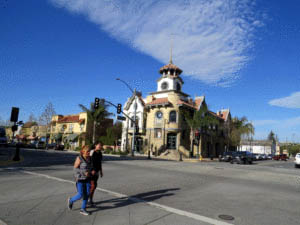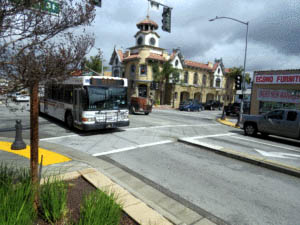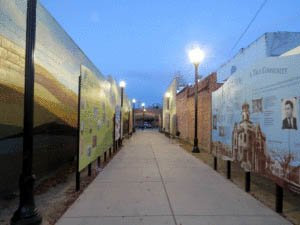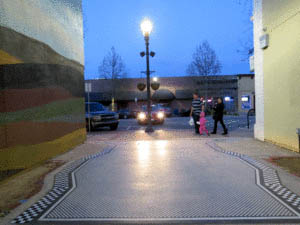Main story: Business association working to improve downtown experience
Looking to connect downtown businesses with surrounding neighborhoods
Published in the April 5 – 19, 2017 issue of Gilroy Life
By Marty Cheek

Photo by Marty Cheek
Two pedestrians stroll along Monterey Street in downtown Gilroy in late March. The Gilroy Downtown Business Association is working to enhance the community’s experience.
To start 2017 with a focused vision, the Gilroy Downtown Business Association brought its 11 board members together for a special retreat to plan what direction to move the organization in the near and far future. If the outcome of that meeting comes to fruition, the public will see exciting changes within the organization that will help strengthen the image of downtown as the historic heart of the city.
One of the most vital things the GDBA wants to do is find areas where merchants, restaurants and other businesses can get more involved with the residents living in the neighborhoods around downtown, said Gary Walton, the GDBA board president, who owns property and has kept his office for 20 years in the district.
“They’re the people who sustain the businesses here,” he said. “If you live in Eagle Ridge, you might come down for dinner once a month, or something like that. But you’re not going to provide that steady business local businesses really need.”
 One national trend that might impact growth and vitality downtown is the fact that Americans are increasingly abandoning their white-picket fences and well manicured lawns in suburb homes and instead moving into downtown districts. There they can enjoy short walks to stores and restaurants and easier connections to train and bus transit systems for daily commutes to work. Much of this urban renaissance is being driven by young people graduating from college and delaying the purchase of a home to enjoy the dynamic life style. Gilroy is looking at adding 105 new dwelling units downtown to take advantage of this trend and thus build a base of residents who will patronize nearby merchants.
One national trend that might impact growth and vitality downtown is the fact that Americans are increasingly abandoning their white-picket fences and well manicured lawns in suburb homes and instead moving into downtown districts. There they can enjoy short walks to stores and restaurants and easier connections to train and bus transit systems for daily commutes to work. Much of this urban renaissance is being driven by young people graduating from college and delaying the purchase of a home to enjoy the dynamic life style. Gilroy is looking at adding 105 new dwelling units downtown to take advantage of this trend and thus build a base of residents who will patronize nearby merchants.
“When you live downtown, you tend to spend more downtown,” Walton said. “We want to encourage that and support more housing downtown and we would love to support our residential neighborhoods around downtown, which is something, normally, a downtown association would not be involved with. It’s important not only to improve your downtown, but you need to improve your neighborhoods.”
 Gilroy’s downtown district is filled with potential to grow into a destination for residents and tourists. Its center is filled with eye-catching architecture, art and infrastructure. It offers visitors an eclectic mix of shops, restaurants, and other businesses blending together in a unique travel experience.
Gilroy’s downtown district is filled with potential to grow into a destination for residents and tourists. Its center is filled with eye-catching architecture, art and infrastructure. It offers visitors an eclectic mix of shops, restaurants, and other businesses blending together in a unique travel experience.
The GDBA board’s retreat in January focused on four “major components” to help promote the downtown culture and shape its economic future, said Melanie Corona, coordinator of the association.
These are to improve the image of the organization and downtown through more social media and collaborative promotions; to take a formal position on the California High-speed Rail, which might build a stop in the downtown; to finish the downtown database and have a “living document” of downtown business owners and stake holders, thus growing a wider reach to include volunteers who help with events and also be involved in committees; and to implement the main-street program to revitalize the downtown’s infrastructure and historical preservation.
 Shopping downtown is a different experience for residents and visitors compared to browsing at a massive shopping mall or outlet stores venue. The established downtown merchants can provide a more personal and localized experience for patrons than is often offered at chain stores.
Shopping downtown is a different experience for residents and visitors compared to browsing at a massive shopping mall or outlet stores venue. The established downtown merchants can provide a more personal and localized experience for patrons than is often offered at chain stores.
“There are advantages that a downtown has that the malls do not have,” Walton said. “The malls exist for one purpose — and that’s to sell you stuff. Downtowns exist for a number of reasons. One, of course, is to sell you stuff. But it’s also a community gathering place. It’s a repository of your city’s history.”
Businesses are privately owned downtown, letting merchants pivot quicker toward meeting their local customers’ needs and also focusing on providing a higher quality level of service, he said.
Communicating more effectively with Gilroy residents as well as potential visitors is something the GDBA board wants to focus on in 2017, Corona said. The nonprofit organization has plans to get the message out that downtown Gilroy is a vibrant place. It plans to do this by using Facebook, Instagram, Snapchat and other web-based publishing systems.
“We’re just trying to reach different aged demographics and people,” she said. “There are people who don’t do social media at all, and we’re trying to balance that as well.”
The misconception of a lack of public safety in downtown Gilroy is another area that the business association will seek to change in 2017, Walton said.
“We had the police department tracking crimes downtown as compared to the rest of the city, and, for the most part, crime downtown was no worse, and sometimes it was better, than the city as a whole,” he said.
The GDBA is working to transform how many residents think of downtown Gilroy, Corona added. “It starts with everyone,” she said. “Any time I hear someone say, ‘Oh, it’s not safe,’ I try to nip that message in the bud. It’s all about the messaging. You hear something negative just once, you always have that impression in your mind.”
Walton sometimes hears people comparing downtown Gilroy unfavorably to downtown Morgan Hill, which is now undergoing its own urban renaissance with more restaurants and shops catering to people who are moving into downtown housing. He discourages the comparison, telling people Gilroy has had a unique brand in the South Valley region throughout the past 100 years. In much of the 20th century, downtown Gilroy was the place where people came from miles around to shop the stores and enjoy the restaurants.
“What we have to do is retain our identity and our flavor and just be real,” he said. “So it’s important to analyze what our assets are and be real to that rather than be something we’re not. People want authentic experiences. They want to know your story. So it’s important for us to understand our own story and tell that story.”
